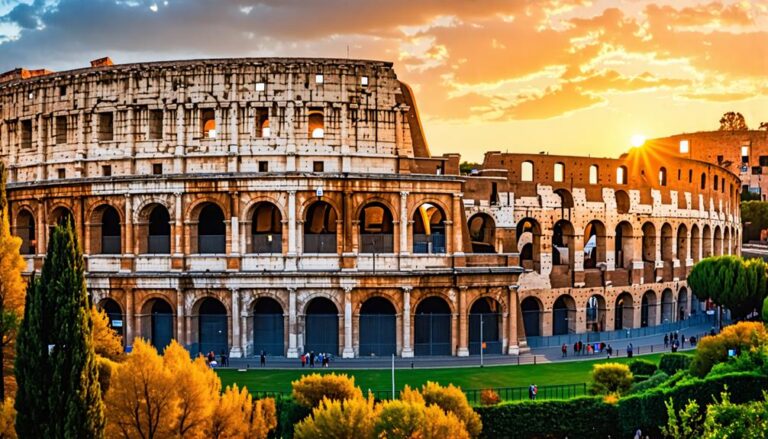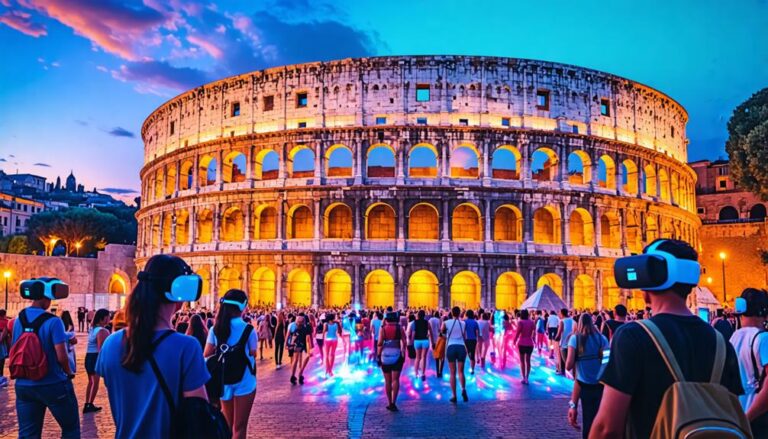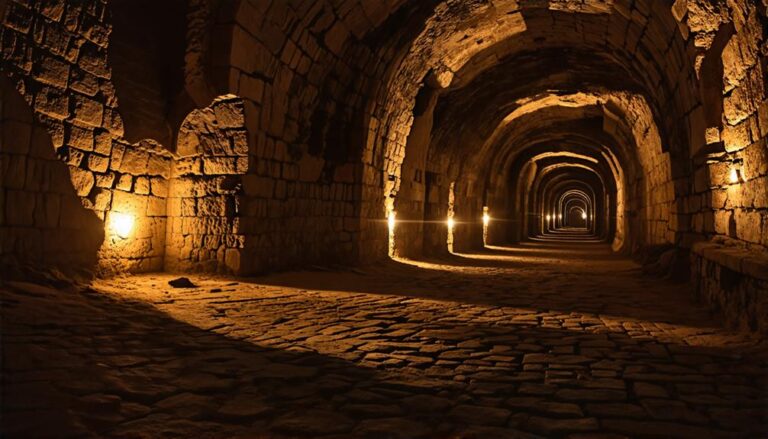Colosseum: Gladiators and Spectacles
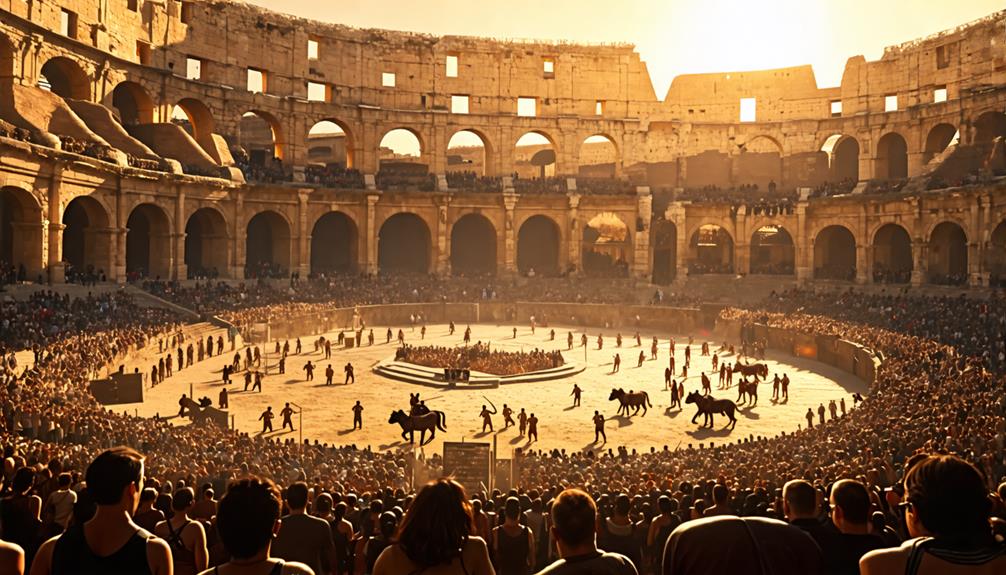
The Colosseum, built between 70-80 AD, stands as a monumental reflection of Roman engineering and societal ideals. This iconic amphitheater hosted events ranging from gladiatorial battles to venationes, where gladiators and trained hunters faced exotic animals like lions and tigers. These spectacles weren’t just about entertainment. They showcased Rome’s military prowess and reinforced social hierarchies among the 50,000 spectators.
When you visit Rome, the Colosseum is a must-see. Imagine the roar of the crowd and the clash of swords. Gladiators, often prisoners or slaves, trained in various fighting styles, adding layers of strategy and drama. The games declined by the 5th century, but the Colosseum’s role in Roman culture and politics remains profound.
As you explore, you’ll uncover more about its fascinating history. The architecture alone is stunning, a testament to advanced Roman engineering. From the underground chambers to the towering arches, every corner holds a story.
Plan your visit to include a guided tour. You’ll gain insights into the lives of gladiators and the events that took place. The Colosseum isn’t just a relic; it’s a window into the past, offering a glimpse of ancient Rome’s grandeur.
Key Takeaways
- The Colosseum in Rome hosted gladiatorial games, animal hunts, and public executions. These events symbolized Roman dominance and power.
- Gladiatorial combat evolved from ancient funeral rites. Trained fighters engaged in distinct styles of combat. These fights ceased by 410 AD.
- The first games in 80 AD lasted 100 days. They featured the slaughter of 9,000 animals, showcasing Rome’s military prowess.
- The Colosseum’s architecture included 80 entrances, tiered seating, and advanced engineering like vaults and arches.
Visiting the Colosseum today offers a glimpse into ancient Roman life. The massive amphitheater stands as a testament to Rome’s engineering and cultural achievements. Imagine the roar of the crowd and the grandeur of the events held within its walls.
Exploring the Colosseum is a must for any Rome vacation. You’ll walk through history, seeing firsthand the ingenuity and might of the Roman Empire. The structure’s design and purpose make it a unique landmark, drawing millions of visitors each year.
When planning your trip, consider a guided tour. These tours provide detailed insights into the Colosseum’s history and significance. It’s an unforgettable experience that brings the past to life.
Historical Overview of the Colosseum
The Colosseum, built between 70-80 AD under Emperor Vespasian, is a monumental tribute to ancient Rome’s architectural brilliance and cultural splendor. It was commissioned to replace the extravagant Nero’s Golden House, symbolizing a return of power to the people of the Roman Empire. With a seating capacity of around 50,000 spectators, the Colosseum was a hub for entertainment, showcasing Rome’s might.
It hosted famed gladiatorial games, venationes (animal hunts), and public executions. These spectacles demonstrated the empire’s strength and provided the populace with a sense of unity and shared experience. The inaugural games, held by Emperor Vespasian’s son Titus in 80 AD, lasted 100 days, setting a precedent for future events.
The Colosseum’s historical significance goes beyond entertainment. It was a powerful tool for political propaganda. Through grand spectacles, the Roman Empire reinforced its authority and captivated its citizens, offering them a sense of freedom and belonging.
When visiting Rome, the Colosseum is a must-see. Imagine walking through its ancient corridors, feeling the echoes of past crowds. It’s an unforgettable experience connecting you to Rome’s rich history.
Construction and Architecture
When you visit Rome, the Colosseum is a must-see landmark. This grand amphitheater, built between 70 AD and 80 AD, stands as a testament to Roman engineering. Made from stone and concrete, it exemplifies the empire’s architectural brilliance.
The Colosseum’s elliptical design, featuring Doric, Ionic, and Corinthian orders, allowed 50,000 spectators to enter smoothly through 80 entrances. This innovative structure set new standards for future buildings.
You can’t help but marvel at the detailed craftsmanship and robust materials used. Exploring the Colosseum, you’ll see how Roman techniques have influenced architectural practices throughout history.
Innovative Structural Design
Vacations to Rome: Sightseeing the Colosseum
The Colosseum’s innovative structural design showcases a blend of engineering and architectural prowess. This ancient amphitheater has influenced countless structures over the centuries. With its elliptical shape, measuring approximately 189 by 156 meters, the Colosseum reflects Roman ingenuity. Architecturally, it combines Doric, Ionic, and Corinthian columns, showcasing the grandeur of Roman design. This multifaceted approach allowed the amphitheater to accommodate up to 50,000 spectators, all with ideal visibility.
To understand the genius behind this iconic structure, let’s break down some key aspects:
| Feature | Details |
|---|---|
| Shape | Elliptical, measuring 189 by 156 meters |
| Architectural Columns | Doric, Ionic, and Corinthian |
| Seating Capacity | Approximately 50,000 spectators |
| Structural Innovation | Complex system of vaults and arches distributing weight effectively |
The tiered seating arrangement maximized visibility. The complex system of vaults and arches distributed the structure’s weight efficiently, enabling its massive scale. The design of the Colosseum served as a model for future amphitheaters and set a precedent for modern entertainment venues. This extraordinary blend of form and function exemplifies the freedom and innovation that defined Roman architecture, capturing our imagination even today.
When planning your vacation to Rome, the Colosseum stands out as a must-see marvel. It offers a unique glimpse into the grandeur of ancient Rome. As you walk through its grand arches and explore its intricate designs, you will connect with history in a profound way. The Colosseum isn’t just an architectural wonder; it’s a symbol of the Roman Empire’s might and creativity.
Imagine standing where gladiators once fought, feeling the weight of history around you. The Colosseum’s enduring legacy continues to inspire awe and admiration, making it an essential stop on any Roman sightseeing tour.
Materials and Techniques Used
When you visit Rome, the Colosseum is a must-see landmark that captures the essence of ancient Roman engineering. Built between 70-80 AD, this iconic structure demonstrates the ingenuity and skill of Roman architects. Using a mix of concrete, stone, and brick, they created a durable and visually stunning amphitheater.
The Colosseum features a blend of Doric, Ionic, and Corinthian columns. These columns not only add to its beauty but also enhance its structural strength. The elliptical shape, measuring about 189 by 156 meters, was an advanced design that optimized sightlines and helped manage crowds. It could hold around 50,000 spectators.
Three key elements highlight the Colosseum’s advanced engineering:
- Vaults and Arches: These provide stability and allow for the rapid movement of people.
- Concrete: This material enabled the creation of a strong and lasting framework.
- Classical Columns: These show the Romans’ mastery of architectural design, blending beauty with function.
The Colosseum’s innovative design influenced future amphitheaters and modern stadiums. Its lasting architectural significance makes it a highlight of any trip to Rome.
Inaugural Games and Early Events
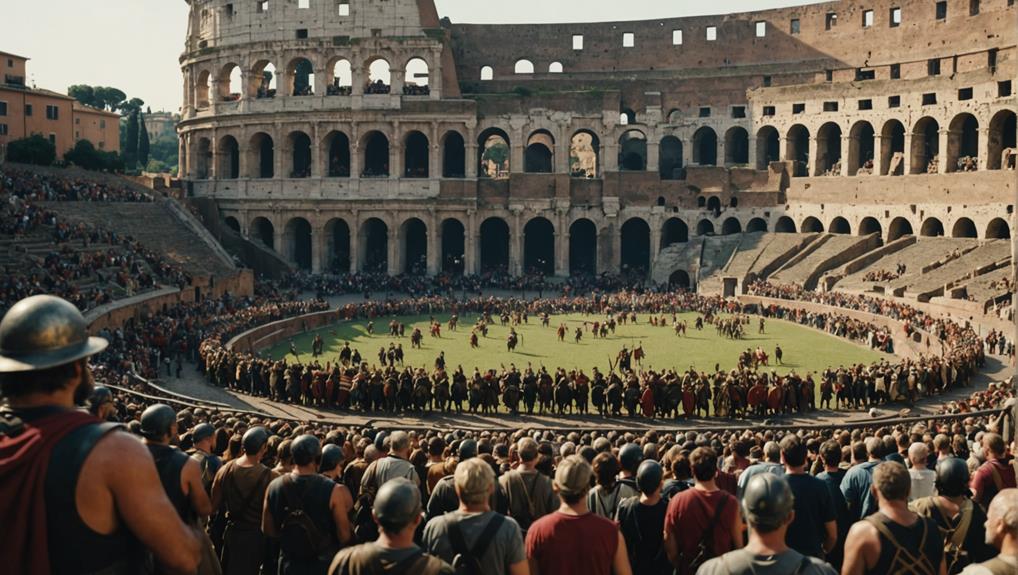
When planning a vacation to Rome, sightseeing at the Colosseum is essential. Emperor Titus inaugurated this architectural marvel in 80 AD with 100 days of grand festivities. This event marked a new era in Roman culture, where public spectacles became central. The Colosseum, with its 80 entrances, could hold over 50,000 spectators, eager to witness the grandeur of the inaugural games.
During these early events, the Colosseum showcased more than gladiatorial games. It also featured venationes, or wild animal hunts. Approximately 9,000 animals were slain, highlighting the scale and extravagance of the festivities. Exotic animals from distant lands were brought in, showcasing the vast reach of the Roman Empire.
The games served to entertain the masses and reinforce Rome’s economic and military power. By staging these grand spectacles, the empire demonstrated its resources, securing the loyalty and awe of its citizens. The inaugural games set the stage for the Colosseum to become a symbol of Rome’s dominance and enduring legacy.
Imagine standing in the arena, where history comes alive. The Colosseum isn’t just a monument; it’s a testament to Rome’s grandeur. So, if you’re planning your trip, make sure to include this iconic landmark in your itinerary. It’s a glimpse into the past that you won’t want to miss.
Gladiatorial Combat
Visiting Rome offers a journey through time, especially when you step into the Colosseum. This iconic structure isn’t just a marvel of ancient engineering; it’s a window into the brutal entertainment that once captivated the Romans. Gladiatorial combat, a cornerstone of Roman spectacles, was more than mere fighting. It began as funeral rites where enslaved people or prisoners of war battled to honor the deceased.
Over time, these combats evolved. By the 2nd century B.C., they became highly organized and commercialized. Official training schools turned gladiators into skilled fighters, each trained in distinct styles. Gladiators like the Secutor and Murmillo, equipped with unique weapons and armor, fought in ways reflecting their specific techniques.
Imagine attending the inaugural games at the Colosseum in 80 AD. The spectacle lasted 100 days, featuring not only gladiatorial fights but also the slaughter of approximately 9,000 animals. This event showcased the sheer scale and brutality of Roman entertainment.
When planning your vacation to Rome, a visit to the Colosseum allows you to step into history. Here’s what you need to know:
- Origins: Gladiatorial combat started as funeral rites.
- Evolution: It developed into organized public entertainment.
- Types of Gladiators: Categories included Secutor and Murmillo.
The decline of these games started around 250 AD, ceasing by 410 AD. Walking through the Colosseum today, you can almost hear the echoes of the past, making your visit to Rome unforgettable.
Venationes: Animal Hunts
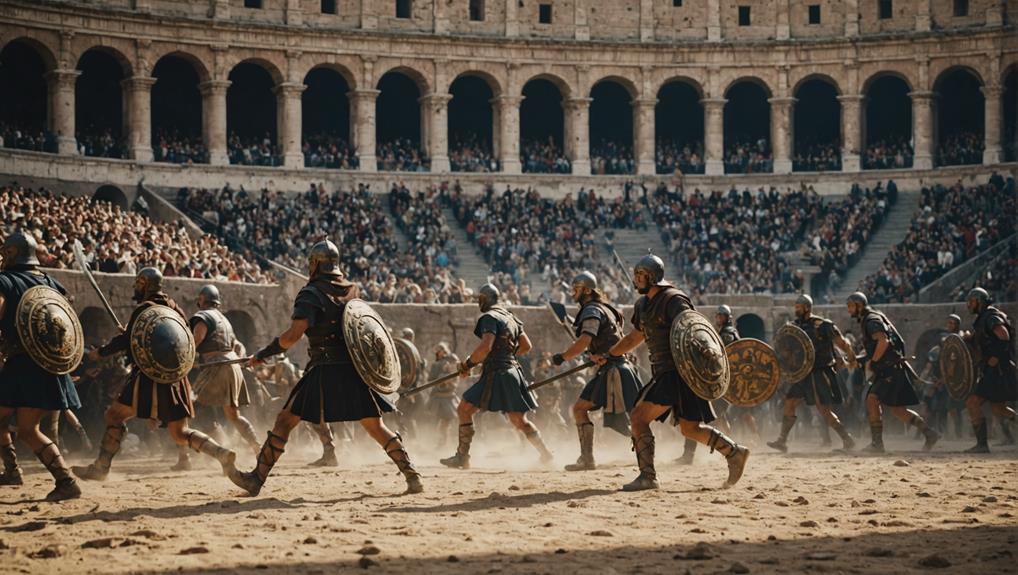
When you plan your vacation to Rome, the Colosseum is a must-see landmark. Among the many spectacles held there, animal hunts, known as venationes, stood out for their grand display of exotic wildlife and Roman power.
These events showcased an array of wild animals from far-off lands, like lions, tigers, and elephants. They highlighted the empire’s wealth and the dangers of nature.
During the inaugural games of the Colosseum in 80 AD, about 9,000 animals were killed. This number shows the scale and brutality of these hunts. They weren’t just for fun; they reinforced key Roman values like bravery and skill.
Trained hunters and gladiators fought fiercely with the animals, showing their mastery and courage. The Colosseum became a stage for Roman strength, thrilling audiences and asserting the empire’s dominance over both man and beast.
Over time, the popularity of venationes declined. Gladiatorial combat began to take center stage in Roman entertainment. Despite this shift, the legacy of these animal hunts remains a vital part of the Colosseum’s history. It reflects the grandeur and complexity of Roman public life.
Your visit to the Colosseum will let you step back in time and witness the remnants of these grand events. This historical site offers a glimpse into the past and the intricate culture of ancient Rome.
Naumachiae: Naval Battles
In our journey through Rome, let’s dive into the marvels of the Colosseum, specifically the naumachiae. These breathtaking naval battles were staged within this iconic arena. First organized by Julius Caesar in 46 BC, these events showcased naval warfare’s grandeur and left the Roman populace spellbound.
The Colosseum’s engineering marvels were on full display during naumachiae. The arena was flooded to create a mock sea where ships clashed in combat. This remarkable feat highlighted the Empire’s logistical prowess. The first naumachiae featured thousands of combatants and numerous ships, underscoring Rome’s organizational excellence.
Here are three captivating aspects about naumachiae:
- Ingenious Engineering: Creating a temporary sea in the Colosseum was an astounding engineering achievement, showcasing Rome’s brilliance.
- Grand Scale: These battles involved thousands of participants, making them some of the most elaborate spectacles of the ancient world.
- Rise and Fall: Despite their initial popularity, the complexity and high costs led to their decline around the 3rd century AD.
As financial and social issues arose, naumachiae lost their charm, mirroring the broader decline of Colosseum spectacles. However, their legacy remains a testament to the extraordinary vision and capability of the Roman Empire.
Chariot Races
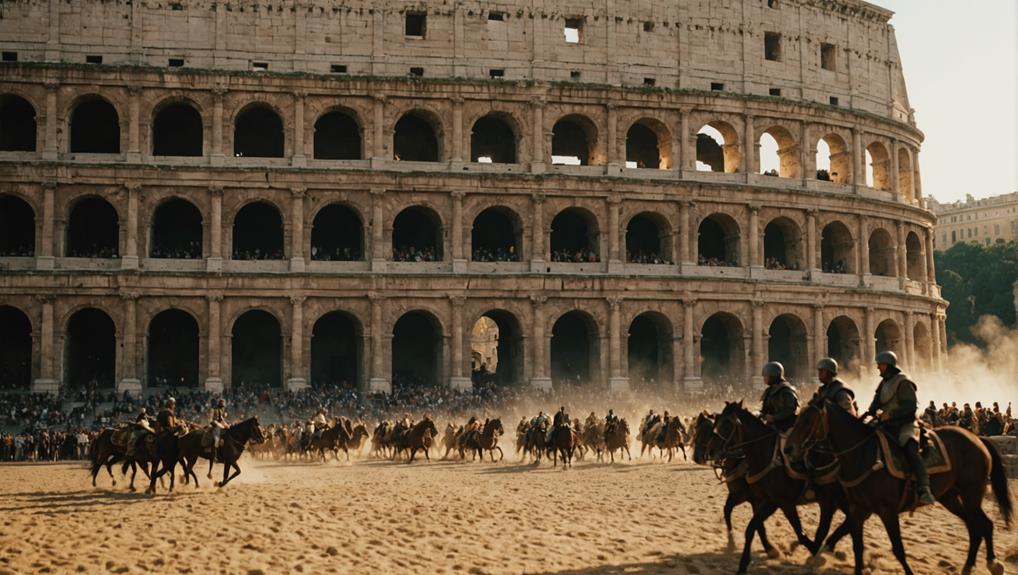
When we think about vacations to Rome, visiting the Colosseum is a must. The Colosseum stands as a monumental example of ancient Roman engineering and architecture. Its massive size and intricate design continue to impress visitors from around the world.
However, many don’t realize that Rome’s grand spectacles weren’t limited to the Colosseum. Chariot races also played a significant role in Roman entertainment. These races, held at the Circus Maximus, date back to the early days of Roman civilization. They evolved into grand events that captivated thousands.
The logistics behind these races were incredible. From the racecourse design to the coordination of teams and horses, everything had to be meticulously planned. The scale of these events was massive. Imagine the excitement of watching chariots speed around the track, the roar of the crowd, the tension in the air.
Chariot races weren’t just for fun; they had a deep cultural and social impact. They reflected societal values and even influenced politics. Leaders used these events to gain favor and showcase their power.
Origins and Evolution
Chariot racing, rooted in Etruscan customs, evolved into one of ancient Rome’s most thrilling and popular forms of entertainment. It wasn’t just a race; it was a display of skill, bravery, and the power of spectacle. While the Colosseum hosted a variety of events, including gladiatorial games, chariot races held at the Circus Maximus stood out for their sheer scale and intensity.
The origins of this sport can be traced back to the Etruscans, who introduced the concept of competitive racing. Over time, it became a staple of Roman culture, enchanting audiences with its blend of speed and danger. Competitors, or aurigae, were often slaves or freedmen who risked their lives in these perilous events. The danger only added to the excitement, drawing massive crowds keen for a taste of freedom and exhilaration.
To better understand why chariot racing was so beloved, consider these points:
- Faction Rivalries: Teams were divided into factions with distinct colors, creating intense rivalries.
- Political Influence: Emperors sometimes swayed race outcomes, adding a political layer.
- Public Spectacle: Races served as major social events, fostering unity and public entertainment.
In essence, chariot racing was more than a sport; it was a vibrant part of Roman life.
Racecourse and Logistics
How did the ancient Romans manage chariot races at the sprawling Circus Maximus? With a capacity for up to 250,000 spectators, the logistics were a marvel. The racecourse, unlike the Colosseum, had an impressive length of 621 meters. This allowed for thrilling spectacles as charioteers completed multiple laps around the central spine, or ‘spina’. The ‘spina’ was adorned with obelisks and statues, adding to the grandeur.
Romans used starting gates known as ‘carceres‘ to ensure a fair start for all competitors. They employed precise timing mechanisms to track the races accurately, bolstering the event’s integrity. Betting added another layer of excitement, with a sophisticated system engaging the audience deeply.
The races featured color-coded teams or factions—red, white, blue, and green—each representing different racing teams. Charioteers, often slaves or freedmen, risked their lives. The most successful among them gained fame akin to modern sports stars. These logistics combined to create a spectacle that captivated audiences. The Circus Maximus stood as proof of their capability to manage large-scale entertainment.
When you visit Rome, don’t miss the chance to explore these ancient marvels. The Colosseum, with its iconic arches and storied past, offers a glimpse into the world of gladiatorial combat. The Circus Maximus, though now a park, still evokes the grandeur of ancient chariot races. Both sites are testaments to Rome’s rich history and their ability to organize grand public events.
Cultural and Social Impact
The immense popularity of chariot races transcended mere entertainment, shaping Roman culture and social dynamics profoundly. These races, held mainly in the Circus Maximus, attracted up to 250,000 spectators. They were a cornerstone of public games. Their impact paralleled gladiatorial contests in uniting and dividing Roman society.
Chariot races weren’t just about speed and skill. They vividly reflected societal values and hierarchies. The races featured teams organized into four factions—Reds, Whites, Greens, and Blues—each fostering intense fan loyalty and rivalry. This had several implications:
- Social Unity and Division: The factions created community among supporters but also fueled rivalries that mirrored broader societal tensions.
- Distraction and Control: By occupying the populace with elaborate spectacles, the races helped maintain social order and prevent unrest.
- Status and Influence: Wealthy patrons who funded teams showcased their status, using the races to assert influence within Roman society.
Chariot races were more than public games. They were a microcosm of the intricate and vibrant tapestry of Roman society.
When planning a vacation to Rome, sightseeing is a must. The Colosseum stands as an iconic symbol of ancient Rome, offering a glimpse into the grandeur and brutality of the past. This majestic amphitheater once hosted gladiatorial contests and public spectacles, drawing crowds much like the Circus Maximus.
Visiting the Colosseum provides a tangible connection to history, allowing you to walk in the footsteps of Roman spectators and feel the echoes of their cheers. Imagine standing in the arena, where gladiators once fought for glory and survival. The Colosseum’s towering arches and intricate architecture tell stories of engineering prowess and societal values.
Exploring this ancient marvel gives you a deep appreciation for the cultural and historical significance of Rome. So, when you plan your trip, make sure to include the Colosseum in your itinerary. It’s not just a sightseeing spot; it’s a journey back in time, a chance to witness the grandeur of ancient Rome and understand the complexities of its society.
Theatrical Performances
Often overlooked in discussions about vacations to Rome, theatrical performances at the Colosseum played a crucial role in Roman entertainment and cultural expression. In ancient Roman times, the Colosseum wasn’t just a venue for gladiatorial games and animal hunts; it also hosted mimes and pantomimes. These performances, with their intricate costumes and scenic designs, showcased the artistic talent and resources of the era. The audience’s engagement during these events was vital, as spectators were expected to respond vocally, enhancing the communal experience and making each performance a shared moment of joy and reflection.
The popularity of theatrical performances at the Colosseum contributed greatly to the spectacle culture that defined ancient Rome. By offering a diverse entertainment program, the Colosseum reinforced social hierarchies and the power of emperors through publicly funded events. This multifunctional venue was a reflection of Rome’s commitment to providing a variety of spectacles that catered to different tastes. This ensured that citizens felt both entertained and connected to their cultural heritage.
| Aspect | Description | Impact on Society |
|---|---|---|
| Type of Performances | Mimes, Pantomimes | Cultural Reflection |
| Costumes and Scenic Designs | Intricate and Artistic | Showcased Talent and Resources |
| Audience Engagement | Vocal Responses Expected | Enhanced Communal Experience |
| Role in Entertainment Culture | Complemented Other Spectacles | Reinforced Social Hierarchies and Power |
When planning a vacation to Rome, visiting the Colosseum offers a glimpse into these historical performances. Imagine standing where Roman citizens once did, experiencing the echoes of their cheers and jeers. The Colosseum’s design, built with careful consideration for acoustics and audience interaction, allowed for these vibrant moments to flourish. This aspect of Roman history highlights the importance of communal experiences in the ancient world, a tradition still valued today.
Event Organization

In ancient Rome, organizing spectacles was a complex and meticulous process, showing the significance of public entertainment in maintaining social harmony. The Colosseum, a marvel of engineering, was central to this event organization. Hosting gladiatorial games required careful planning and execution. Emperors, like Augustus, took a hands-on approach, personally overseeing public games to guarantee their appeal and legitimacy.
Efficient crowd management was essential. The Colosseum’s 80 entrances allowed quick and orderly access, accommodating thousands of spectators. This efficiency was critical for maintaining order and maximizing enjoyment.
Here’s how they did it:
- Seating Arrangements: Seats were assigned based on social status. Senators, military personnel, and other social classes had designated areas. This careful organization upheld the social hierarchy even during leisure activities.
- Funding and Special Events: Emperors often funded these spectacles. They showcased unique animals and special events. This generosity demonstrated their power and connection with the populace.
- Festivals and Frequency: Festivals occupied over half the year. Frequent events emphasized the significance of public entertainment. This regularity kept the populace engaged and content.
Through meticulous event organization, the Colosseum became a symbol of Rome’s grandeur and emperors’ benevolence. These spectacles remained a cornerstone of Roman culture.
Social and Political Significance
When planning vacations to Rome, the Colosseum stands out as a must-see landmark. This ancient amphitheater offers unique insights into Roman history and culture. The seating arrangements tell a story of social hierarchies. Senators and elite guests had the best seats. They didn’t just get comfort; they got a front-row view that reinforced their status.
The Colosseum wasn’t just a place for entertainment. It was a tool for rulers to connect with the public. Spectacles like gladiator fights helped distract people from political issues. These events also maintained social order. The emperor used them to show his power and his bond with different social classes.
Visiting the Colosseum gives you more than just a glimpse of ancient architecture. You also get to see how the Romans lived and interacted. This site is rich with history and significance. Make sure it’s on your list when you plan your Rome sightseeing adventures.
Seating and Social Hierarchy
Vacations to Rome: Colosseum Sightseeing
When you visit Rome, the Colosseum is a must-see landmark. Its seating arrangements reflected the strict social hierarchies of ancient Rome. The best seats were reserved for senators and elite guests. The emperor played a key role in organizing these arrangements, which guaranteed that social order was maintained and his authority reinforced. This organization not only showcased the emperor’s power but also highlighted the deep class distinctions of the time.
The seating was structured to reflect one’s social standing, ensuring that the elite and powerful were prominently positioned. Here’s how it broke down:
- Senators and Distinguished Guests: They occupied the front rows. These seats had the best views, highlighting their political and social dominance.
- Military Personnel: They sat separately from civilians. This placement reinforced their importance and maintained order during events.
- Married Plebeians and Higher Status Individuals: They had designated sections. Their seating reflected their social stature, ensuring clear class distinctions.
Restrictions on women’s attendance emphasized male dominance. The emperor’s oversight of seating arrangements showed his connection to the people. This careful orchestration of seating facilitated the spectacle and reinforced Rome’s social and political structures.
When you tour the Colosseum, imagine the vibrant history and the intricate social order that once dictated where people sat. This ancient amphitheater isn’t just a marvel of engineering; it’s also a window into the fascinating social fabric of ancient Rome.
Imperial Power Display
When you visit Rome, the Colosseum is a must-see. This ancient amphitheater isn’t just a relic; it’s a vivid reminder of Rome’s storied past. The Colosseum, with its grand arches and imposing structure, tells tales of gladiatorial combats and epic spectacles.
The seating arrangement inside the Colosseum reveals much about Roman society. Senators and dignitaries had the best seats, close to the action, while the common people sat further away. This setup highlighted the emperor’s power and political influence. The Colosseum wasn’t merely for entertainment; it was a stage for showcasing imperial Rome’s might.
Emperors like Augustus used these events to strengthen their political legitimacy. By funding grand spectacles, they showed their wealth and generosity, creating a strong connection with the people. The Colosseum became a place where the emperor could foster loyalty and admiration. When the crowd greeted him with white handkerchiefs, it signified their collective approval and allegiance.
These spectacles served as strategic displays of imperial power. The emperor’s ability to host such lavish events illustrated Rome’s strength and stability. The Colosseum became a powerful symbol of the emperor’s unparalleled authority and the empire’s enduring dominance.
Public Engagement Strategies
When planning your vacation to Rome, a visit to the Colosseum is a must-see. This iconic amphitheater offers more than just stunning architecture; it provides a glimpse into ancient Roman life. Emperors hosted grand spectacles here to engage with the public and showcase their power and generosity.
Emperors often personally oversaw gladiatorial games. Their presence created a direct connection with the people. This made the public feel entertained and valued. It was a powerful tool to engage with citizens.
The seating arrangements within the Colosseum also played a significant role. Senators and distinguished guests received priority seating. This affirmed the emperor’s authority and reinforced social hierarchies. Everyone understood their place within society.
Elaborate performances featuring exotic animals and skilled gladiators captivated audiences. These spectacles provided a much-needed distraction from societal unrest. They also cultivated a sense of unity and shared experience among the diverse Roman populace.
On your visit, imagine the roar of the crowd and the thrill of the games. The Colosseum is a window into a world where politics, power, and entertainment merged. It’s a place where history comes alive.
Audience Behavior and Etiquette
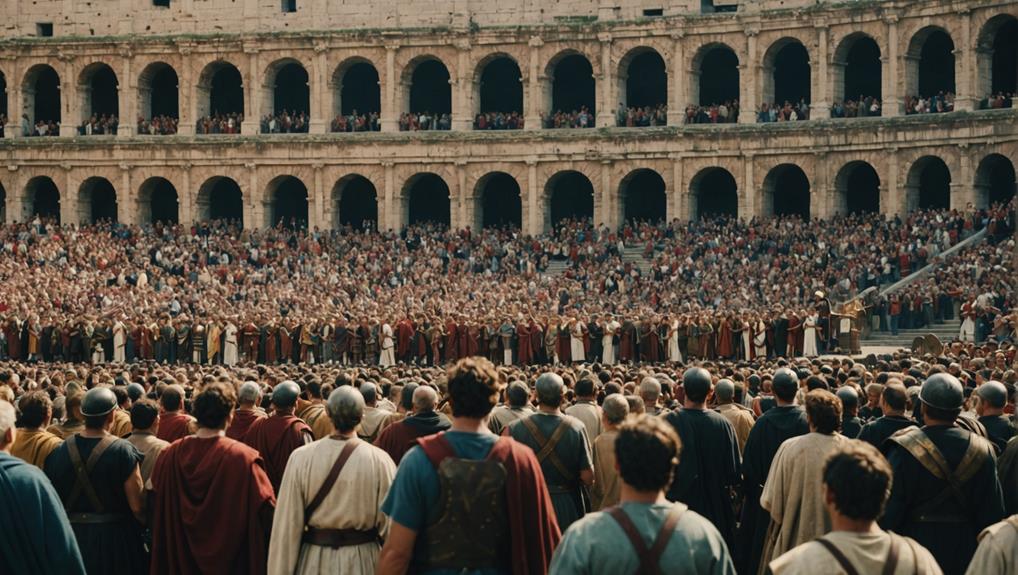
When visiting the Colosseum on your vacation to Rome, it’s fascinating to imagine how spectators adhered to a strict code of behavior to respect both the event and their social customs. The grandeur of the spectacles remained undisturbed thanks to a sense of decorum.
Spectators wore the gala toga, symbolizing social status and respect for the occasion. This attire highlighted the importance of the events and their role within them.
Eating and drinking during performances were prohibited to maintain focus and decorum. This rule ensured that attention stayed fixed on the spectacles, allowing full immersion in the experience. During processions, spectators stood to honor imperial and divine figures, showing reverence and acknowledgment of their significance.
The demeanor of the crowd was closely watched. Augustus emphasized the importance of proper behavior to restore traditional customs. Spectators often greeted emperors with white handkerchiefs, a practice demonstrating homage and emotional engagement. This collective display of respect created a strong sense of unity and shared purpose, reinforcing the cultural and social values of the time.
When you visit, imagine the powerful atmosphere, the sense of unity among the crowd, and the grandiosity of the events. The Colosseum isn’t just a historic site; it’s a window into the social and cultural fabric of ancient Rome.
Decline of the Games
The Colosseum’s decline as a venue for gladiatorial games between 217 AD and 523 AD was driven by financial strain and changing social attitudes within the Roman Empire. A series of disasters, including fires and earthquakes, caused significant damage to the Colosseum. These events strained the empire’s finances, making it harder to maintain the grand structure and fund the costly games.
The rise of Christian emperors who opposed the brutal nature of gladiatorial combat played an essential role. Emperor Honorius suspended the games in 404 AD. By 438 AD, Emperor Valentinian abolished them altogether. As the games faded, the Colosseum started evolving from a symbol of public entertainment to a mere quarry for building materials.
By the 6th century, animal hunts continued until about 523 AD, but gladiatorial combat had largely ceased. This marked the end of an iconic era in ancient Rome. The decline of the gladiatorial games can be attributed to several key reasons:
- Financial difficulties due to disasters and the empire’s overall economic strain.
- Christian opposition leading to legislative actions against the games.
- Societal shifts away from violent spectacles towards different forms of public engagement.
Today, when you visit Rome, the Colosseum stands as a majestic testament to ancient history. Despite its decline, it remains an essential stop for any sightseeing vacation. As you walk through its ancient arches, imagine the roaring crowds and the fierce gladiators. This historical monument provides a window into the past, offering a vivid glimpse of ancient Roman culture and architecture.
Taking a vacation to Rome and visiting the Colosseum is more than just a trip. It’s an exploration of history, a stroll through time. The grandeur of the Colosseum, even in its ruined state, speaks volumes about the past glories of the Roman Empire. So, make sure to add this iconic landmark to your travel itinerary for an unforgettable experience.
Later Uses of the Colosseum
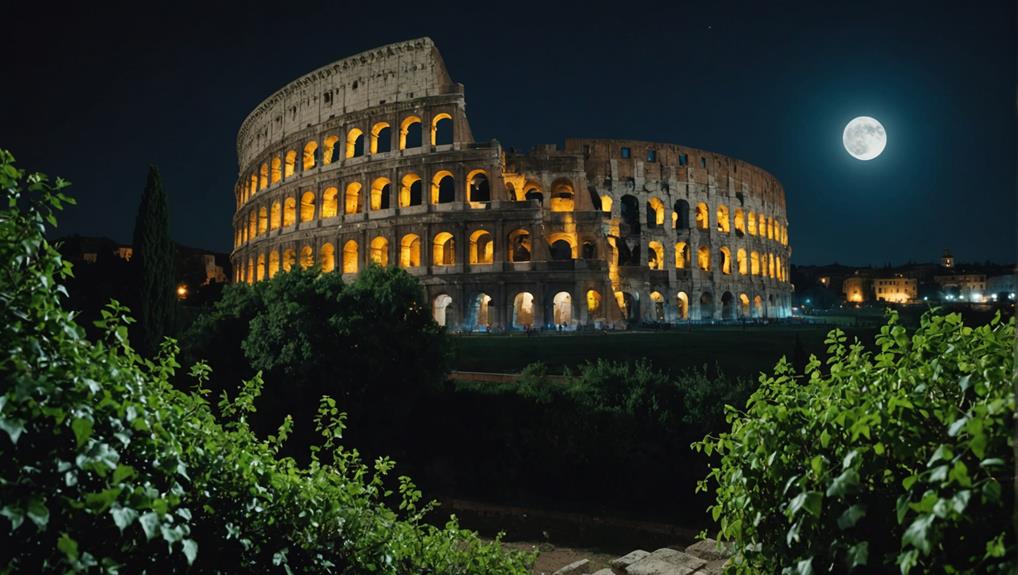
The Colosseum isn’t just a relic of ancient Rome; it’s an essential stop on any vacation to the Eternal City. When the gladiatorial games ended in the 5th century, the Colosseum took on new roles that mirrored the changing needs of Roman society. First, it became a fortress under the Frangipane family. This massive structure also housed a chapel, shifting from a place of violence to one of sanctuary.
By the 16th century, the Colosseum served as a quarry. Its stones were used to build significant landmarks across Rome. Despite this, it remained a cultural icon. By the 11th century, it was known as the Colosseum, named after a colossal statue of Nero that once stood nearby.
In 1750, Pope Benedict XIV consecrated the Colosseum to honor Christian martyrs who were believed to have died there. This marked a profound change in its significance. What was once a venue for gladiatorial games became a Christian memorial. It embodied a new narrative of sacrifice and faith. The Colosseum also hosted public executions sanctioned by the Pope until these practices were abolished.
Each transformation of the Colosseum shows its enduring adaptability. This historic landmark continues to capture the imagination of visitors. A trip to Rome would be incomplete without exploring its ancient arches and learning about its multifaceted history.
Modern Restoration Efforts
Restoration efforts for the Colosseum began in 1776, sparked by a lightning strike that highlighted the need to preserve this iconic monument. Since then, the drive to maintain and restore this symbol of cultural heritage has remained strong. The 1880s and 1890s saw major initiatives aimed at stabilizing the structure and enhancing its historical integrity. These early efforts laid the groundwork for the ongoing projects we see today.
In the 1990s, restoration ramped up to address wear and tear from tourism and environmental factors. A major focus has been the Colosseum Underground, the hypogeum, where gladiators and animals were once held. Excavations have provided deeper insights into the Colosseum’s historical use, enriching our understanding of this ancient marvel.
When you plan your vacation to Rome, here are three key restoration activities to appreciate:
- Structural Stabilization: This ensures the Colosseum remains standing for future generations.
- Hypogeum Excavation: This uncovers the secrets of the Colosseum Underground.
- Tourism Management: This balances visitor access with preservation needs.
Today, the Colosseum stands as one of Europe’s most visited attractions, a testament to our unyielding dedication to preserving its legacy. When visiting, you can marvel at this ancient structure, knowing that continuous efforts keep its history alive for all to see.
Frequently Asked Questions
What Was the Major Purpose of the Spectacles in the Roman Colosseum?
When you visit Rome and see the Colosseum, you might wonder about the major purpose of its spectacles. These events were designed to exercise social control, reinforce cultural identity, and serve as political propaganda. They distracted people from daily issues while showcasing the emperor’s power and legitimacy.
The Colosseum’s grandeur was not just architectural. It symbolized the might of the Roman Empire. The spectacles included gladiatorial combats, animal hunts, and public executions. These events captivated the masses and promoted unity among the citizens.
What Spectacles Were Held in the Colosseum?
When you visit Rome, the Colosseum is a must-see. This ancient amphitheater hosted thrilling spectacles. They held animal hunts, mock naval battles, and theatrical performances. Imagine 9,000 animals killed in 100 days! These events showcased Roman power and captivated audiences. They remind us of the high cost of freedom and control. Explore the grandeur of the Colosseum and step back into history.
Which Romans Participated in and Which Watched the Spectacles in the Colosseum?
We saw Roman spectators from all social classes. Senators and nobles had the best seats. Commoners filled the stands. Gladiator training was rigorous. Despite social restrictions, everyone watched these gripping spectacles with enthusiasm.
When you visit Rome, the Colosseum is a must-see. Imagine the grandeur of ancient times. You can almost hear the roar of the crowd. See where emperors sat. Feel the history under your feet. It is more than a structure; it is a journey back in time.
The Colosseum stands as a testament to Roman engineering. Its arches and walls tell stories of past events. Each stone has a story to tell. As you wander through this ancient marvel, you get a sense of the culture and society of ancient Rome.
Rome offers many sights, but the Colosseum remains iconic. Whether you are a history buff or just curious, this monument captivates everyone. So, pack your bags and prepare for an unforgettable adventure through time.
Why Do You Think the Romans Loved Watching Violent Spectacles Like Gladiatorial Combat?
Visiting Rome is like stepping back in time. One of the must-see sights is the Colosseum, an architectural marvel. This ancient amphitheater once hosted gladiatorial combat. These fights were more than just brutal entertainment. They were a reflection of Roman culture and social structure.
People flocked to the Colosseum for the thrill and spectacle. Watching these combats offered a unique escape from daily life. The courage and skill of the gladiators were awe-inspiring. It was a way to experience a sense of freedom through their valor.
The Colosseum itself is a symbol of Rome’s grandeur. Its massive structure and intricate design speak volumes about Roman engineering. As you walk through its arches, you can almost hear the echoes of the past. Imagine the roar of the crowd, the clash of swords, and the intense atmosphere.
Exploring the Colosseum is a highlight of any trip to Rome. It’s a place where history comes alive. You can learn about the social hierarchy of ancient Rome and the psychological appeal of these violent spectacles. It’s a fascinating glimpse into a bygone era.
Conclusion
Explore the Colosseum’s grand history, from its majestic construction to the thrilling gladiatorial combats and animal hunts that captivated ancient Rome.
As the games faded and new purposes emerged, the Colosseum adapted, yet its magnificence never waned. Modern restoration efforts ensure this colossal amphitheater remains a testament to human creativity and endurance.
We’ve only touched the surface of its legacy, but one thing’s certain—the Colosseum stands as an eternal symbol of Rome’s unyielding spirit.
When you visit Rome, make sure the Colosseum is at the top of your sightseeing list. Its towering arches and intricate architecture speak volumes about the engineering prowess of ancient Romans.
Walk through the expansive corridors and imagine the roar of the crowd during a gladiatorial fight. As you stand in the arena, envision the fierce battles that once took place here.
Feel the weight of history and the courage of gladiators. The Colosseum is more than just a structure; it’s a living piece of history that offers a unique glimpse into the past.
For those interested in architecture, the Colosseum is a marvel. Its design has influenced countless structures around the world. Notice the Doric, Ionic, and Corinthian columns, each showcasing different aspects of Roman architectural brilliance.
Don’t forget to take a guided tour. Expert guides will provide fascinating insights into the Colosseum’s construction, its role in Roman society, and the lives of those who fought and died here.
Rome offers many treasures, but the Colosseum is a must-see. It’s a reminder of the city’s glorious past and a beacon of its indomitable spirit.
